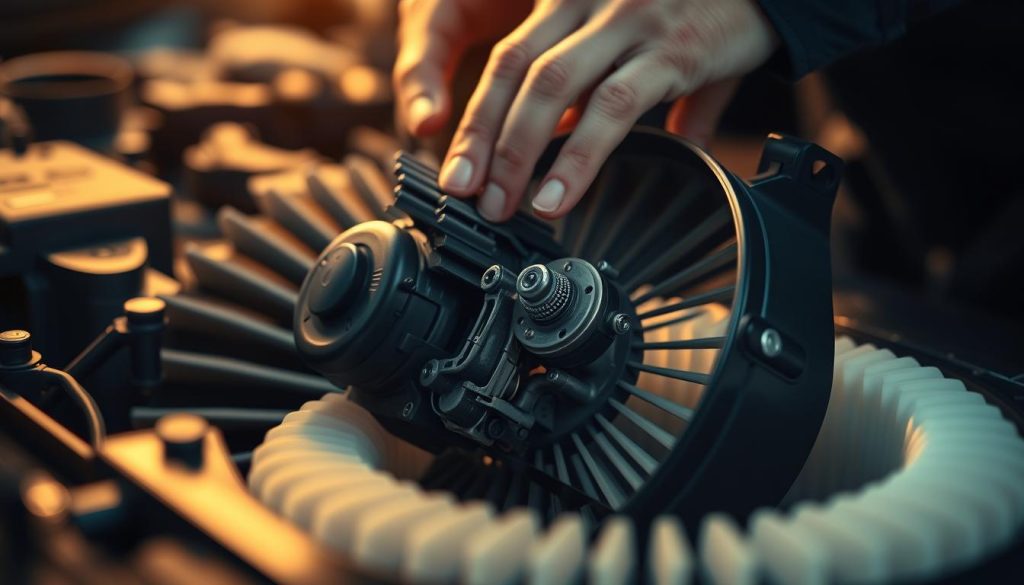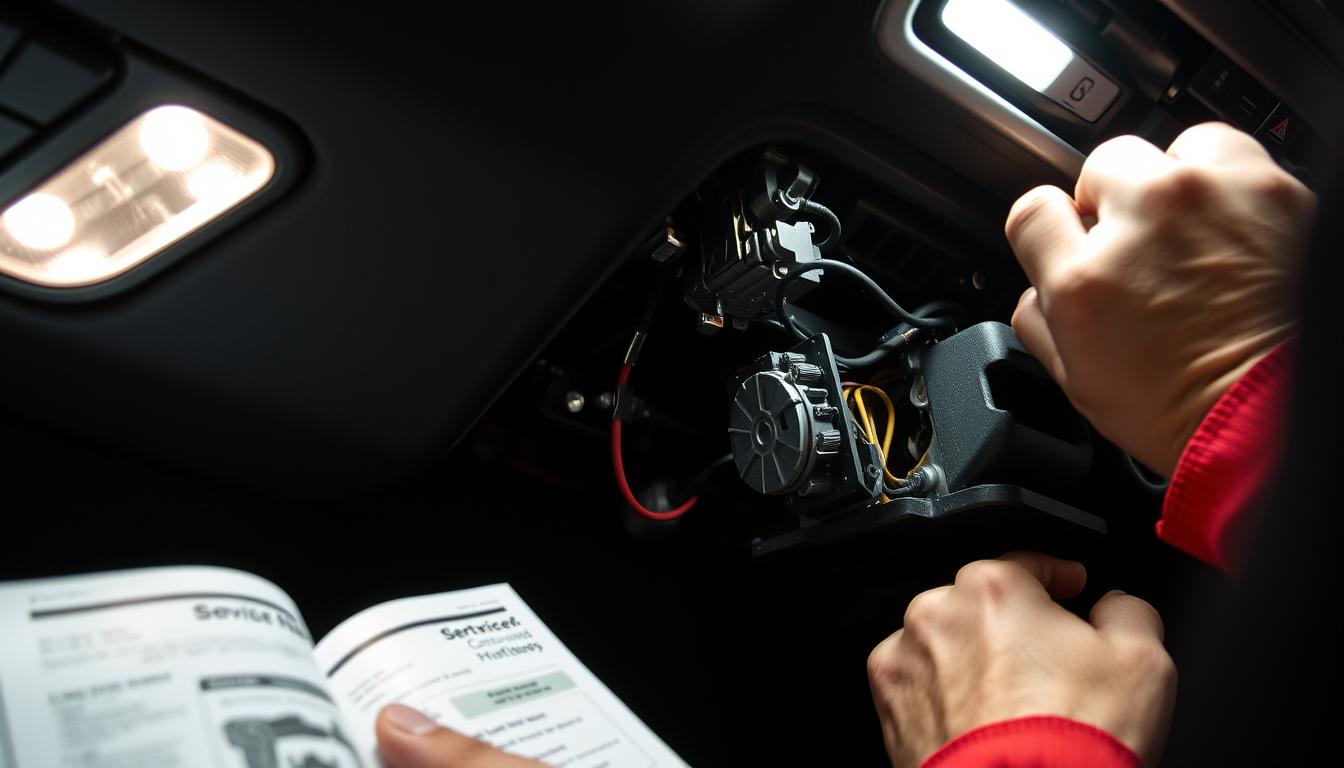Nothing’s worse than a chilly drive during winter—especially when your heating system suddenly stops working. Whether you’re facing weak airflow, cold drafts, or no heat at all, understanding the root cause can save you time, money, and frustration. Let’s break down how these systems operate and what steps you can take to resolve common problems.
Most heating systems rely on a blend of components like the heater core, coolant, and HVAC controls. Hot coolant flows into the heater core, and a fan blows warm air into your cabin. When something disrupts this process—like low coolant, a clogged core, or a faulty thermostat—you’ll feel the chill.
This guide walks you through practical fixes, from checking fluid levels to troubleshooting electrical connections. We’ll also help you decide when a DIY approach makes sense versus seeking professional support. After all, some tasks require specialized tools or expertise to ensure safety and long-term reliability.
Key Takeaways
- Heating systems depend on coolant flow, airflow, and functional controls to operate.
- Low coolant levels or air pockets often cause immediate heating failures.
- Thermostat malfunctions or clogged heater cores require careful inspection.
- Electrical issues with fans or controls may need professional diagnostics.
- Regular maintenance prevents many common cold-weather breakdowns.
By the end, you’ll know how to tackle minor issues confidently and recognize when it’s time to contact experts like Heaven Automotive. Let’s get you back on the road with warmth and peace of mind.
Understanding Your Car Heater System
Knowing how warmth reaches your cabin helps spot issues faster. Most systems rely on three key parts working together: the heater core, coolant, and thermostat. Let’s explore how these components create cozy drives—and why experts like Heaven Automotive trust this process.
Parts That Make Warmth Possible
The heater core acts like a mini radiator hidden behind your dashboard. Hot coolant from the engine flows through its tiny tubes, releasing heat into the air. A blower fan then pushes this warmed air through your vents.
The Coolant-Thermostat Partnership
Your engine’s coolant mixture—half water, half antifreeze—absorbs heat as it circulates. The thermostat acts as a gatekeeper, opening only when the engine reaches 195–220°F. This ensures hot coolant reaches the heater core only when needed, balancing engine health and cabin comfort.
If any part fails—like a stuck thermostat or clogged core—cold air blows instead. Regular coolant checks and core inspections prevent most issues. For complex fixes, our team at Heaven Automotive uses specialized tools to restore heat efficiently.
Identifying Common Heater Issues
Is your vehicle blowing cold air when you need warmth? Let’s uncover why this happens. Most heating failures stem from a handful of recurring problems—issues we’ve solved countless times at our shop. Pinpointing the source early saves time and keeps repair costs manageable.
Faulty Thermostat and Electrical Components
A malfunctioning thermostat ranks as the #1 culprit in heating failures. When stuck open, your engine never warms up enough. If closed, it risks overheating while blocking heat transfer. Both scenarios leave you with chilly vents.
Electrical gremlins complicate things further. A dying blower motor might hum weakly or stay silent, trapping warmth in the core. Faulty switches or frayed wiring can also disrupt commands to your HVAC system. Our technicians use voltage testers and scan tools to trace these hidden issues quickly.
Low Coolant Levels and Clogged Heater Core
Without enough coolant, there’s nothing to carry heat from the engine to the cabin. Leaks or evaporation often cause low levels—check your overflow tank when the engine cools. Persistent low fluid hints at deeper problems like head gasket failures.
Clogs form silently over time. Rust flakes, stop-leak products, or old coolant sludge can block the heater core’s narrow tubes. You’ll notice weak airflow or sweet-smelling mist on the windshield. Flushing the system often helps, but severe blockages may need core replacement.
Spotting these signs early prevents bigger headaches. If you’re unsure about symptoms, our team at Heaven Automotive offers free initial assessments to get your heat flowing again.
Step-by-Step Car Heater Repair Instructions
Now that you’ve identified potential issues, let’s roll up our sleeves and restore warmth to your vehicle. These repairs require patience and attention to detail—we’ll walk through each stage together.
Preparing for the Repair: Safety and Tool List
Never rush into repairs without proper preparation. Start by parking on level ground and letting the engine cool for 20 minutes. Hot coolant can cause severe burns, so this step isn’t optional.
Gather these essentials:
- Drain bucket and funnel
- Wrench set (sizes vary by vehicle)
- Fresh 50/50 coolant mix
- OEM thermostat (check your manual)
Replacing the Thermostat and Refilling Coolant
Locate the thermostat housing near the radiator’s base. Place your drain bucket underneath, then carefully remove the housing bolts. Swap the old part for the new one, ensuring the rubber gasket seals properly.
Refill the system slowly through the radiator opening. Use your funnel to prevent spills. Start the engine and let it idle for 5 minutes—this helps purge air pockets. Check the coolant level again after your first drive.
Pro tip: If you spot leaks or the heat still won’t kick in, our team at Heaven Automotive uses pressure testers to diagnose hidden issues quickly. Some jobs simply need expert hands.
DIY Troubleshooting Tips
When warmth escapes your cabin, start with simple checks before diving into complex fixes. Many heating problems stem from accessible components you can inspect without specialized tools. Let’s walk through two critical areas where DIY efforts often yield quick results—and when to call reinforcements.

Inspecting the Heater Fan and Blower Motor
Start your engine and crank the temperature dial to max. Listen closely—a healthy blower should hum steadily within seconds. Silence often means a dead motor, while grinding noises suggest worn bearings or debris trapped in the housing.
If airflow feels weak but warm, the fan might spin slower than normal. This could indicate electrical issues like corroded connectors or frayed wires feeding power to the motor. Our team at Heaven Automotive often finds these during routine diagnostics.
Checking HVAC Controls and Wiring
Test every button and dial on your dashboard. Sticky temperature valves or unresponsive settings hint at control module failures. Don’t overlook the fuse box—a single blown fuse can disable your entire system.
Electrical gremlins require careful handling. Exposed wires or melted insulation near the blower resistor demand professional attention. For tricky cases, our technicians use multimeters to trace voltage drops and pinpoint faults safely.
Remember: While basic checks save money, complex electrical work risks damaging sensitive components. We’re here to handle the heavy lifting when your DIY journey hits a roadblock.
Effective Car Heater Repair with Heaven Automotive
Even the most dedicated DIYers encounter challenges that demand professional attention. If your cabin stays chilly despite basic fixes, it’s time to consider expert support. Complex heating systems often hide interconnected issues only trained technicians can unravel efficiently.
Signs It’s Time for Professional Service
Persistent cold airflow after refilling coolant or replacing thermostats suggests deeper problems. Electrical glitches—like flickering dashboard controls or inconsistent fan speeds—signal wiring or module failures. Our team frequently resolves these through advanced diagnostics most drivers lack.
Another red flag? Temperature fluctuations that defy simple explanations. If warmth comes and goes randomly, hidden blockages or failing sensors might be sabotaging your comfort. We’ve seen cases where debris in the core or aging blend doors create these frustrating patterns.
Expert Diagnosis and Reliable Repairs
At Heaven Automotive, we start with a full-system scan to map out root causes. Our tools detect voltage irregularities, sensor errors, and airflow restrictions invisible to untrained eyes. This precision prevents guesswork and unnecessary part replacements.
- Specialized Core Replacements: Replacing heater cores often requires dismantling dashboards—a task our technicians perform without damaging surrounding components.
- Electrical Mastery: From frayed harnesses to faulty resistors, we trace and repair circuitry issues using manufacturer-grade equipment.
- Guaranteed Comfort: Every repair includes post-service testing to ensure consistent warmth across all cabin zones.
Don’t gamble with winter drives. Trust our certified professionals to restore your vehicle’s heating system to peak performance—safely and swiftly.
Maintenance and Prevention for a Healthy Heating System
Keeping your vehicle’s heating system reliable starts with consistent care. Small preventive steps today save you from frosty surprises tomorrow. Let’s explore how simple routines keep warmth flowing smoothly through every season.

Regular Coolant and Antifreeze Checks
Your cooling system is the lifeline of cabin warmth. Check fluid levels monthly—the overflow tank should sit between “min” and “max” marks. Low levels starve the heater core of heat-transferring liquid. We recommend flushing old coolant every five years or 100,000 miles, but shorten this interval if you notice heating hiccups.
Use a 50/50 antifreeze-water mix year-round. This blend prevents freezing in winter and boiling in summer. Debris from degraded coolant can clog the heater core’s narrow tubes, reducing efficiency. Our team at Heaven Automotive offers free top-offs during inspections to keep your system clean.
Scheduled Inspections of HVAC Controls
Modern climate systems rely on precise electronic signals. Test all dials and buttons quarterly—sticky switches or delayed responses hint at looming failures. Frayed wires behind the dashboard often cause erratic behavior, especially in older models.
Watch for these red flags:
- Whirring noises when you turn the heater on
- Temperature swings between vents
- Damp carpets or sweet odors (heater core leaks)
We catch 92% of developing issues during our 30-point HVAC checks. Early detection means simpler fixes—like replacing a $15 resistor instead of a $400 control module.
Stay ahead of winter woes with our maintenance plans. Heaven Automotive bundles coolant flushes, pressure tests, and electrical diagnostics into one affordable package. Because nothing beats peace of mind when temperatures drop.
Conclusion
Winter drives shouldn’t leave you shivering—understanding your vehicle’s heating system helps tackle most cold-air frustrations. We’ve explored how low antifreeze levels, stuck thermostats, or electrical glitches disrupt warmth. Simple fixes like coolant top-offs often work, but stubborn temperature inconsistencies or weak airflow signal deeper trouble.
Persistent issues demand expert attention. Our team at Heaven Automotive uses advanced diagnostics to pinpoint hidden problems—whether it’s a failing valve, clogged heater core, or faulty control module. Don’t gamble with DIY guesses when frosty mornings arrive.
Need reliable heat fast? Trust our certified technicians to restore comfort efficiently. Schedule a free initial assessment today and keep your cabin cozy all season. Because winter waits for no one—and neither should your vehicle’s heating system.

